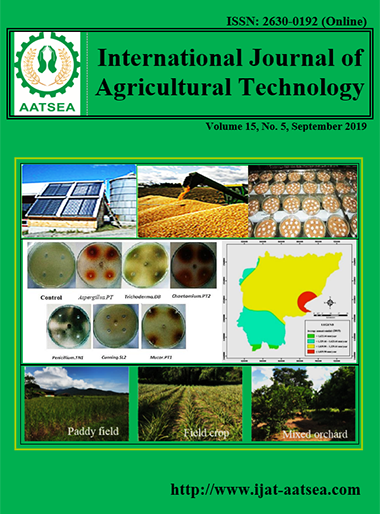Environmental responsibility of rice var. Kum Bangpra and Riceberry in lowland and upland conditions
Main Article Content
Abstract
Rice (Oryza sativa L.) var. Kum Bangpra is improved purple pericarp variety from pure line selection for five years during in-season and off-season to yield the desirable phenotypic characters. The chemical and physical properties were compared with Riceberry in lowland and upland conditions. Result revealed that the two rice varieties under lowland conditions was significantly differed in plant growth paramet ers eg. plant height, tillers, harvesting time, panicle’s number per hill, and yield. Kum Bangpra variety gave the highest yield of 705.80 kg. per Rai. Riceberry resulted to yield 462.20 kg per Rai, which the growth parameters and yields were similar resulted in upland and lowland conditions. Kum Bangpra variety and Riceberry yielded 654.80 and 412.60 kg. per Rai, respectively. It is noticed that Kum Bangpra variety gave greater yield than Riceberry in both conditions. In lowland condition found that Kum Bangpra variety expressed straw-colored husk, round grain shape, dark purple husked grain, gelatinization temperature at 67°C, soft and sticky cooked rice. Whereas Riceberry revealed dark purple husk, long and slender grain, dark purple husked grain, gelatinization temperature at 70°C, and incoherent soft cooked rice. Kum Bangpra variety contained greater amount of GABA, protein, fiber, omega 3, gamma oryzanol, and antioxidants than Riceberry. It is suggested that Kum Bangpra variety found low starch and amylose content of 7.15 % which is considered to appropriate the dietary and sugar intake.
Article Details

This work is licensed under a Creative Commons Attribution-NonCommercial-NoDerivatives 4.0 International License.
References
Abbaspour, N., Hurrell, R. and Kelishad, R. (2014). Review on iron and it’s important for human health. Journal of research in medical sciences, 19:164-74.
Abdoulaye, B. (2008). Metabolic and structural role of thiamine in nervous tissues. Cell mol neurobiol, 28:923-931.
Ahmed, I., Qazi, I. M., Li, Z. and Ullah, J. (2016). Rice noodles: materials, processing and quality evaluation. B. Life and Environmental Sciences, 53:215-238.
A.O.A.C. (1995). Official Method of Analysis. 16th ed. The Association of Official Analytical Chemists, Arlington, Virginia.
A.O.A.C. (2012). Official Method of Analysis. 20th ed. The Association of Official Analytical Chemists, Arlington, Virginia.
Bao, J., Cheung, W. Y. and Wu, J. Y. (1995). Brain L-glutamate decarboxylase. Inhibition by phosphorylation and activation by dephosphorylation. Journal of Biological Chemistry, 270:6464-6467.
Champagne, E. T., Wood, D. F., Juliano, B. O. and Bechtel, D. B. (2004). The rice grain and its gross composition. In. Rice Chemistry and Technology. American Association of Cereal Chemists Press, Minnepolis, pp.77-107.
Christos, T. C., Ariadni, C. L., Chara, A. S. and Maria, E. S. (2012). Zinc and human health. Arch toxicol, 86:521-534.
De Datta, S. K. and Zarate, P. M. (1970). Environmental conditions affecting growth characteristics, nitrogen response and grain yield of indica rice in the tropics. Agronomy Journal, 60: 643-647.
Diana, M., Quilez, J. and Rafecas, M. (2014). Gamma-aminobutyric acid as a bioactive compound in foods: a review. Journal of Functional Foods, 10:407-420.
Dyall, S. C. and Michael-Titus, A. T. (2017). Neurological benefits of omega-3 fatty acids. Neuromol Med, 10:219-235.
Frei, M. (2003). Studies on in vitro starch digestibility and the glycemic index of six different indigenous rice cultivars from the Philippines. Food chemistry, 83:395-402.
Leslie, S. B. and James, S. (1999). The effects of tropical vitamin E on the cosmetic appearance of scars. Dermatol Surg, 25:311-315.
Makarchikov, A. F. (2009). Vitamin B1: Metabolism and functions. Biomedical chemistry, 3:116-128.
Nakagawa, K. and Onota, A. (1996). Accumulation of gamma-aminobutyric acid (GABA) in the rice germ. Food Processing, 31:43-46.
Ngamchuen, K. (2003). Rice and Rice Quality. Department of Agriculture. Bangkok. pp.359.
Onanong, N. (2007). Rice: Science and Technology. 2nd Edit. Kasetsart University Press, Bangkok.
Rizvi, S., Raza, S. T., Ahmed, F., Ahmed, A., Abbas, S. and Mahdi, F. (2014). The role of vitamin E in human health and some diseases. Sultan Qaboos University Medical Journal, 14:157-165.
Rushton, D. H. (2002). Nutritional factors and hair loss. Clinical and experimental dermatology, 27:396-404.
Shahida, A. K. and Ahmed, M. (2017). Dietary changes with omega-3 fatty acids improves the blood lipid profile of wistar albino rats with hypercholesterolaemia. International journal of medical research and health sciences, 6:34-40.
Tester, R. F. and Morrison, W. R. (1990). Swelling and gelatinization of cereal starches. waxy rice starches. Cereal Chemstry, 67:558563.
Wanchai, T. (1998). Thai Rice: Taste, Seeds, and Journey. Sarakadee Magazine, 14:114-132.
Yoshida, S. (1981). Fundamentals of Rice Crop Science. International Rice Research Institute, Los Baños, Laguna, Philippines.


